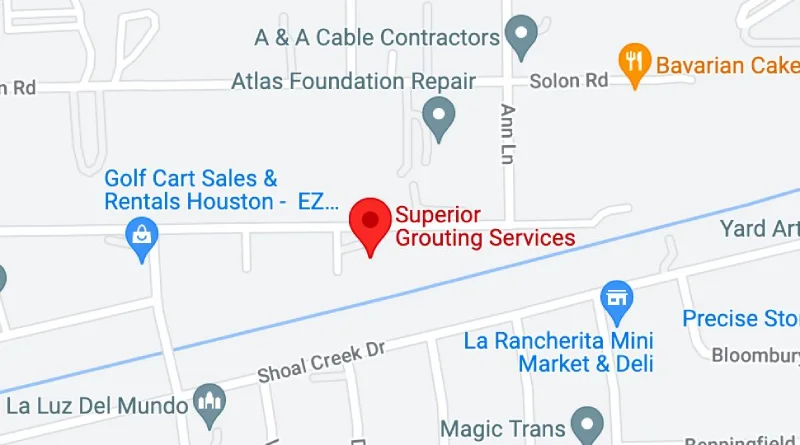What Is Void Fill in Houston, TX?

Houston’s massive petrochemical plants, rail yards, airport aprons, and port terminals all rely on thick concrete structures that simply cannot shut down for long. When empty spaces—better known as voids under concrete slabs—develop, they jeopardize safety, throughput, and the bottom line. Industrial-scale void fill services in Houston restore load-bearing capacity quickly by injecting high-density polyurethane foam that expands, compacts loose soil, and locks everything back into place. Below you’ll learn why voids form, how modern foam technology works, and what to expect from a reliable void-filling partner.
Key Takeaways
- Gulf Coast clays, heavy rainfall, and constant vibration create hidden cavities beneath concrete surfaces.
- Polyurethane foam reaches 90 % strength in 15 minutes, minimizing operational downtime.
- Foam weighs only 3–4 lb/ft³, so it stabilizes the subsurface and prevents further settlement without adding load.
- Data-driven lift monitoring protects nearby infrastructure and delivers long-lasting solutions.
- A Houston-based crew that understands TxDOT, port, and refinery safety protocols will keep your project compliant and on schedule.
Why Do Voids Form Beneath Industrial Concrete in Greater Houston?
Expansive Clays and Seasonal Moisture Swings
Houston’s soils contain high percentages of montmorillonite clay that swell when saturated and shrink when dry. The resulting shrink-swell cycles leave an uneven void space beneath concrete structures, creating unsupported pockets that gradually widen.
Continuous Heavy Loads and Dynamic Vibration
Container cranes, gantry systems, 18-wheelers, and rail traffic generate constant impact that shakes fines loose. Over time, the soil beneath loses density, leading to cavities that compromise even the thickest concrete slab.
Poorly Compacted Backfill Around Utilities
Sanitary and storm sewer pipes, water supply or drainage lines, and other conduits are installed with pneumatic or drilling equipment. If backfill isn’t properly compacted, those excavations act as conduits to the subsurface void, letting water migrate, erode fines, and cause settlement along the pipe trench.
Groundwater Movement and Erosion
Intense Bayou City rain events scour materials from beneath slabs and pavements. Where drainage is inadequate, hydraulic flow will literally wash support soils away and create voids that spread laterally.
Natural Subsidence
Regional groundwater withdrawal lowers formations and adds another vector for settlement. The effect is magnified in low-lying industrial zones near the Ship Channel.
The Void Fill Process—Step by Step
- Site Evaluation and Non-Destructive Testing
Ground-penetrating radar maps the extent of the void under your concrete.
Core samples verify soil type, moisture content, and any structural damage. - Injection Plan and Engineering Approval
A grid pattern with ⅝-inch ports is designed to match slab thickness and the cavity geometry.
Engineers select the proper fill solution—standard, hydro-insensitive, or ultra-high-density foam. - Precision Drilling and Port Installation
Small holes mean minimal disruption. Reinforcing steel is avoided to preserve structural integrity.
Pneumatic drilling equipment keeps dust low, ensuring clean ports for adhesion. - Polyurethane Injection
Two liquid components merge at the nozzle. Within seconds, the material expands 25×, filling these voids entirely.
Technicians monitor real-time pressure and laser elevations to level the slab without over-lifting. - Quality Assurance and Cleanup
Load-plate testing confirms compressive strength of 100–150 psi—more than enough for crane wheels.
Ports are trimmed, sealed, and traffic lines repainted so the surface looks and functions like new.
Why Polyurethane Beats Cementitious Grouting
- Lightweight but Strong: Traditional mudjacking grout weighs 120 lb/ft³. High-density polyurethane foam typically weighs 4 lb/ft³ yet delivers superior compressive strength. Lower mass helps stabilize the subsurface and prevent subsidence.
- Rapid Return to Service: Foam cures fast. In most cases, lanes, decks, or runways reopen within one hour. Cement grout can require multiple days, costing facilities valuable time.
- Environmentally Friendly: Closed-cell foam will not leach chemicals, resists water infiltration, and limits haul-off because no extra cement, sand, or water is hauled in or out.
- Smaller Footprint: A self-contained pump rig replaces fleets of concrete trucks. The jobsite stays cleaner, reducing conflict with ongoing operations.
Industrial Applications for Void Fill Solutions
Port & Rail Infrastructure
Wharf aprons, rail spurs, and intermodal pads suffer pounding from container lifts and train traffic. Foam void fill services deliver fast stabilization without removing rails or shutting down a berth.
Airport and Runway Pavements
Runways, taxiways, and aprons near Bush Intercontinental require stringent flatness tolerances. Concrete leveling with foam meets FAA specs overnight, not over weeks.
Refinery and Petrochemical Plants
Process areas feature pipe racks, containment dikes, and slab-on-grade equipment foundations. Small voids can cause alignment issues and costly shutdowns. Foam injection keeps production online.
Municipal Roadways and Bridge Approaches
From the inner loop to suburban toll roads, uneven approaches cause impact loading and maintenance headaches. Polyurethane void filling services in Houston eliminate bump-at-the-bridge complaints quickly.
Warehouse and Distribution Floors
Autonomous vehicles and high-bay racking demand perfectly flat floors. Concrete void filling solutions make floor joints flush again and extend joint-seal life.
Cost Factors and Return on Investment
- Depth and Cubic Volume: Foam is sold by the pound. Deeper cavities or large plan areas require more material; however, even high-volume injections often cost 30–50 % less than slab replacement.
- Access and Operational Constraints: Night work, classified zones, or hot work permits add labor premiums. A coordinated plan reduces those extras.
- Engineering Requirements: Specialty foams for hydrocarbon resistance or ultra-high PSI cost more but may be mandatory in refineries or chemical loading zones.
- Downtime Savings: Calculate how many truckloads, flights, or throughput hours are saved by a one-night repair versus multi-day replacement. Frequently, the effective void treatment pays for itself immediately.
Selecting a Houston Void Filling Partner
- Local Geotechnical Knowledge: A contractor familiar with Gulf Coast clays, subsidence mapping, and storm-surge drainage designs a better fill solution.
- Certifications and Safety: Look for ACPA or URETEK licensing, EMR under 1.0, TWIC cards for port access, and ISNetworld compliance. A proven safety culture protects both crews and client facilities.
- Data-Driven Communication: Expect pre-job reports, live lift monitoring, and post-project elevations. This documentation satisfies insurers, asset-integrity engineers, and municipal reviewers.
- Comprehensive Services: Top providers pair concrete leveling, deep soil stabilization, and foundation repair for turnkey delivery. If nearby piles or footings need remediation, one team handles it all.
- Long-Term Performance and Warranty: A minimum two-year workmanship warranty is standard. Extensions may be available when deep soil stabilization accompanies void filling.
Contact Us Today for a Free Estimate
Uneven pavement, rocking precast panels, or racked equipment foundations don’t fix themselves. Superior Grouting offers void fill services to stabilize industrial assets across Greater Houston. Our high-density polyurethane foam, experienced crews, and engineer-approved processes let you restore your concrete fast and with confidence. Contact us for a no-obligation site walk and estimate. We’ll tailor the most reliable void-filling services available—keeping your operation safe, level, and on schedule.

